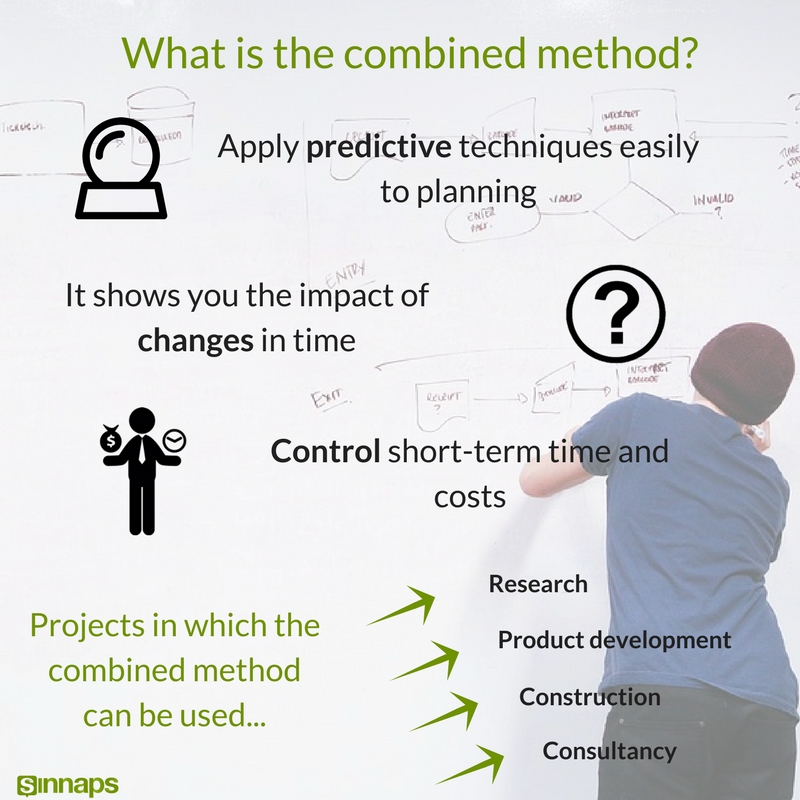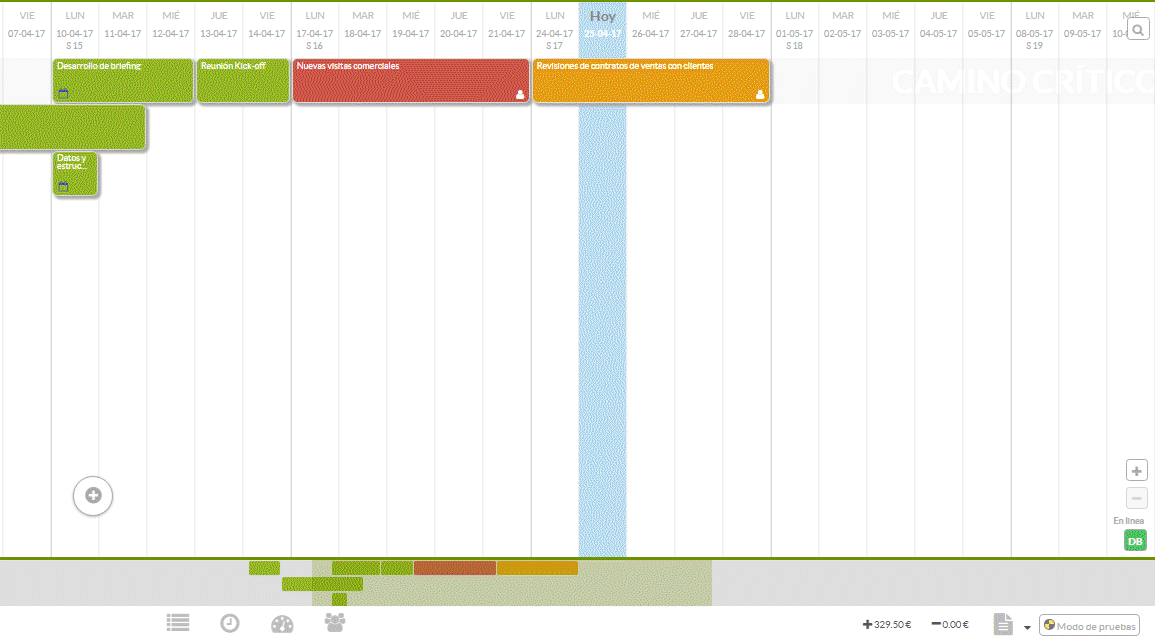Índice
The combined method is revolutionising project management. But, when and how should it be used?
Identifying the project method types depending on what you are going to work on is the key to defining the type of planning you need to do. Basically, there have always been three: the agile, predictive and chaos methods. Now a fourth has appeared: a combined agile/predictive method.
This first lesson is not about learning how to plan using each method, as a load of literature already exists on this matter. However, what there is not a lot of is information about how to identify when you should plan in one form or another.

Although agile methods are now very popular and have a great number of champions, the truth is they are not the one-stop solution. If you want to know how to plan, read some of our tips from the Academy, or look at some of the suggested reading at the end of this lesson.
In both my experience working at Sinnaps and after having spoken to many companies, I have learnt there are different types of project which have very different needs. But, first, I will give you an overview of the basic features of the project methodology types.
The predictive methods
These are the ones that have always been there. They were the first to appear, during the 50s, when organisations began to systematically apply project administration tools and techniques to highly complex engineering projects.
Predictive methods are those which try to envisage the needs of your project so you can manage it based on these predictions.
They work pretty well, but the problem is they are too inflexible for many types of project. Projects which have a certain degree of complexity or level of uncertainty are difficult to manage. There are many predictive techniques, among the best-known of which you will find:
- Gantt: The standard format for graphically illustrated planning.
- PERT: Detecting links and dependency between activities in a work network, also estimating possible times/delays.
- CPM (Critical path): Detecting the work flow that will determine the minimum duration of your project.
- EVM (Earn value): Assesses the development of your project based on your plans
compared to real resource costs to predict whether the project in progress will be successful or is heading in the wrong direction.
Additionally, predictions are also achieved using a type of descriptive study or various types of qualitative studies. With the two forms, we can see the behaviour of the various elements in accordance with specific issues.
As you can see, all these techniques are very useful; however, if something unexpected occurs, we are in real trouble. What is more, some of them are difficult to understand, so a minimum of training is necessary to use them.
And that means that in projects with a lot of unexpected issues, continuous maintenance by Project Management (PM) is required.
On the other hand, they are great for complex projects with various types of resources where management can have a direct impact on project costs. The predictive value is positive or negative in the diagnostic test.
Let’s say that whenever you need to coordinate, procure, hire, order or reserve things, people or money over a week in advance, you are going to need to (or you should) use techniques to predict your needs.
The agile methods
Very trendy! These have been widely accepted in recent years. Contrary to the predictive methods, these are not based around a timeline, but rather a prioritisation of tasks instead of planning things out. To do this, a list of things to do is created and they are prioritised so, once there is availability among the team members, new things will be chosen to be done based on what has been learnt during the preceding stage.
These techniques are designed to pursue incremental development and manage the work of all the people involved as well as possible. Additionally, an attempt is made to limit the scope as far as possible in order to finish as many useful things as possible in the shortest possible time.
Unlike the predictive techniques, these are great when we look at projects with high degrees of uncertainty. However, they are really bad at predicting what we are going to need tomorrow.
Types of agile methodology (most common)
SCRUM: the Scrum method has its advantages and disadvantages. It defines the ‘Sprints’ or blocks of work into a few weeks so as to establish the project result based on the activities that are found to be needed. At the end of each ‘Sprint’, the result is analysed and the scope of the next decided.
Kanban: a method that creates a list on a panel of activities which need doing; these are then prioritised and pursued through different stages of development, testing and validation. These are based on a series of simple criteria which help to maintain order.
Agile: this way of working is more based on testing and optimising results to attain the optimum, most tested product possible.
There are many others. All of them have their roles and rules, but this here is just an introduction. Enough for now. In any case, if you want to know more about all this, there is a lot available online.
What is most interesting about these methods is that they are the best at managing uncertainty. You can start a project without having much of a clue about what you need to do and end up with a great product.
But… don’t be fooled. They do not work for everything. Unlike with the predictive methods, these will not help you much if you have to work out what you will need or be doing in the short to long-term.
Remember that the agile methods appeared in the software design sector, where the biggest resource to be managed is people’s hours, as product maintenance and development is a continuous process with some very specific fixed costs.
Chaos
Chaos is a wonderful way to manage a project. It is great fun and thoroughly liberating. It allows you to plan because you can do what you want when you want, and it also manages uncertainty perfectly. You only need to stop doing one thing and move onto the next.
In theory, chaos is the best way to manage a project, so almost all small and medium enterprises use it – not to mention its use among many large companies.
Types of chaos
— Excel-lent chaos: this is very dangerous as, despite the boss telling us: ‘Draw up an Excel’, the decision is based on no other criteria than putting everything into tables. And there you have it: your perfect Excel where you can see things in order in tables, giving you the feeling of order.
— Chicken run chaos: This is easy to see and identify because it means everyone is basically doing what they want when they want. It tends to work very well for tiny projects.
— Traditional chaos: When a company does things in a particular way with no apparent logic, but has always run that way. Nobody knows why things happen this way nor do they ask because it seems to work. Here you will hear: ‘We’ve always had this system and we always will’.
These are the three most common ways to manage chaos and they work pretty well for small projects, with just a few people involved and a small budget. But they have two problems:
Firstly, it is by no means the best way of doing things and may turn out to be really expensive while giving you no time to react. Secondly, it does not cope well with a change of context. When the project or company grows, it leads to a bad atmosphere… It is a real ticking time-bomb and may lose you your entire business.
The combined method
As we have seen, agile methods are wonderful because they manage uncertainty really well. On the other hand, predictive methods help us forecast the costs and needs for our project. In my experience and in the sectors in which I have worked, most projects need to manage uncertainty AND predict needs. That, for me, is why the most effective way is to combine the best of each.
Dwight D. Eisenhower said: ‘Plans are useless, but planning is indispensable’. Honestly, I totally agree. Why?
As I have said on other occasions, planning is organic and evolves along with the project. That is why you need to plan flexibly.
When managing projects here at Sinnaps, we use predictive methods to plan months in advance. Each week we go back through our plans, after the follow-up or Monday meetings. This means that as the date for doing tasks approaches, the planning activities are reorganised and made more specific. In other words, the closer the activity comes, the more defined and the more content is added.
So: When we start each activity, we create a ‘backlog’ – or cache of things to do – based on sub-tasks and we manage it in an agile way. For me, that is the key factor!
Medium- and long-term planning should be done using predictive methods, while agile techniques are more practical for the short term.
Thus, we achieve the following:
☞ Predictive techniques are easier to apply because they are used with activities that are not highly defined.
☞ We can tackle the day-to-day uncertainty with agile methods and see the impact on the medium- and long-term planning on a weekly basis.
☞ Short-term development is carried out within controlled cost and time parameters which are defined by our medium-term planning. This allows us to predict what each thing is going to cost and know what we are going to be working on in a month’s time.
For the day-to-day planning and management, we use Sinnaps. It is very complete and enables us to plan and re-plan easily and agilely. It also applies predictive techniques automatically. Thus, after every change, we can see the estimates of what the change is going to cost us in every way.
We use Youtrack for agile management of the tasks we are working on, to change validation status, etc.
We have also used Trello, Asana and Redmine, previously. They all work really well, and if we use one rather than another it is because we like to try things out, or because of technical issues that I do not understand too well…
The fact is that now we plan everything like this, I feel that managing most projects using just the agile or just the predictive method is reckless. In many cases, it is tantamount to using chaos.
For example, we use the simulations in the Sinnaps Testing Mode to make changes and see how they affect the project, before implementing them. Let me show you an example of the combined method:

What do these project types need?
Do you work on any like these?
Let me tell you what I have learnt about the various project types by sector and need. This way, I hope to help you define what you need and work out your best solution. 😉
Research projects
Research projects have particular characteristics which are worthy of special attention.

- First off, scientific research is never over. Projects start at a specific time, but have no identifiable end. They last for years.
- Research projects tend to ensure their funding based on medium-term budget items, so they experience sudden interruptions and start back up again after being stalled for months. What is more, they tend to see a rapid turnover in personnel and team size. This means they need data transfer and easily accessed information.
- They do not have a specific defined goal because nobody knows what may be found, nor do they have a set date by which to do so. Thus, they often hit cul-de-sacs which means they are regularly replanning.
- They are typically dependent on technological resources, like patents, machines or facilities, so they need detailed follow-up on costs and an optimisation of resources.
In my experience and for all of these reasons, I would not recommend using agile methods to programme a research project. The combined method could fit in well with this sort of project.
Will you help me out? 😉 If you liked this content, please share it on social networks. Thank you!!
Development projects
A typical development project is defined by the following features:
— Teams of people from different disciplines tend to work together, sometimes with limited availability or shared across projects. This is why poor resource (personnel) management can substantially increase project times.
— They tend to have a fixed deadline by which time the product must be ready and working, no matter whether or not all the specifications have been fulfilled. Therefore, we are going to need to both predict our needs and prioritise tasks to fit in with the timeframe.
— In the case of services, there is generally a greater dependency on human resources. However, with products, our needs are more material resource-based. With this latter case, the ability to predict the usage of these resources becomes a necessity.
— With product development projects, we tend to be restrained by strategic business needs, which means we also need to keep a cap on costs and be able to predict financial availability in order to meet payments. And this despite using a resource on a specific date, because you are likely to need to have the money in the bank a month before. All of this needs to be ready. So, the combined method would be very good for this project type.
— In software development projects, it is above all personnel costs that are managed, so you need to be more on the ball with your fixed costs than with your suppliers. Agility works very well with software development projects.
Quality and customer service projects
Quality projects is the name I give to projects which are designed to control product quality. This can be in the form of a service call centre or a quality department for software dedicated to sorting out bugs.
— They are indefinite projects where the priorities change on a daily basis. The aim is to resolve customers’ issues or overcome errors; there is no specific objective in sight. This is why it is very interesting to use agile methods, while planning goes into the background.
— Costs vary little and are, mostly, on personnel.
— These projects tend to have a significant knowledge transfer requirement and particularly rigid quality protocols. That is why I recommend using ticket management tools, rather than pursuing predictive planning.
Construction projects
These projects can be highly complex. In fact, the UE is implementing the new BIM standard to regulate the expenditure and scope of large-scale projects.
— Construction projects have lengthy implementation periods. However, unlike research projects, they have very specific goals and a fixed deadline.
— You need to define some mid-points which ensure you maintain control in the key moments.
— Construction projects require many multi-disciplinary teams to work together, so good communications are essential.
— The success of a project is directly linked to medium-term resource availability, so you need to predict resources, costs and anything else imaginable.
— With this sort of project, most actions are done physically, so it is difficult to really maintain control over what is happening. This also complicates communication and knowledge of what each team is doing at all times. It is difficult to make plans.
— Construction projects have to cope with a lot of uncertainty. There tend to be lots of unexpected developments on site or in terms of project materials or specifications. However, the work is so costly, so physical and there is so much interdependence among the various disciplines that using agile methods is a non-starter.

The construction sector has one peculiarity, which is, given that it is unrealistic to be constantly planning, agile methods are not workable. Planning management is done through what is known as ‘base lines’. A base line is a point in the planning for which particular objectives deemed realistic are fixed – similar to a milestone. Later, you work based on what has been planned and deal with the unforeseen as well as you can.
The deviation from the base line is controlled through the progress review meetings.
In fact, this is a combined method in which predictive techniques a little like the ‘sprints’ from the SCRUM method are used (base lines). The difference is that changing construction specifications is difficult – you cannot just remove columns from a bridge – so budgets tend to be modified to adapt them to the deviations. That is why it is normal for construction projects to be undertaken with cost overruns.
Consultation projects
Consultation projects also tend to have certain features that make them unique.
— To start with, these are projects based on the use of human resources, where neither costs nor work hours vary much. There are normally variable costs – allowances, trips, etc. – which tend to be set basically from the beginning.
— Unlike research or software development projects, they have very specific objectives from the start and, in theory, they are subject to fixed deadlines.
— There is not much uncertainty in these projects in terms of method as they typically depend on legal procedures or well-tested methods. So, it is practical to make predictive plans to define the scope of the project.
— There tends to be uncertainty, though it is possible to manage it in the short term. This means using a combination of methods is also very practical.
— The management of milestones and deliverables will determine success. However, they may go on forever if the scope, deliverables and control points are not carefully overseen.
Manufacturing / production process
Manufacturing processes are very different from other project types. They start with a process that has already been checked and is in place to make something, so they need to focus on optimisation. It is important to clarify that starting an assembly line is a developmental process, while once the line is in operation, the needs change and it becomes a continuous improvement process, based on market factors. The Kaizen Method is used by many companies which are looking to improve process quality.

— Manufacturing and continuous improvement processes are very similar to result quality processes. Unlike the latter, production processes are not focused on improving the result but rather on improving the process itself. In other words, the project becomes the result.
— These processes are focused on resource optimisation (material, machine and human), so planning needs to be perfectly controlled. However, as the planning is always the same, replanning is not often needed. Only minor changes need to be put into practice.
— Preventive maintenance is required constantly, as are planned breaks.
— With these processes, we should also be focused on improving the tech, so they tend to go hand-in-glove with or parallel to various development projects. This may mean we have to use these breaks for testing and reconfiguring the machines.
— Su objetivo es claro, mejorar de forma constante el proceso.
— The goal is clear: to constantly improve the process.
Thus, the best method for this tends to be the combined one. New activities come up every day, but the objectives are long-term. So, it is necessary to plan agilely albeit with long-term predictions. And that is possible with the combined method.
—
Good! Now you are more aware of the needs that various projects can have based on type and/or sector. From the outside, they may seem similar. However, it is important to understand the complexities of each of them and why one technique is more useful than another at times. What I also want is for you to be able to evaluate when someone recommends using one method or another.
Naturally, the description of the project type and method is an approximation. It may well vary in your sector. Nonetheless, do not focus on that, but rather on identifying the features that distinguish your project from others.
As I said at the beginning, I will give you some reading about the agile and predictive methods. In this video, XBox PDM Eric Brechner speaks about the Kanban agile project management technique. He has used this practice with various work groups for the last few years. How to organise labels Some tips and advice from Eric Brechner in this video.
Next time…
I will explain how to organise a Kick Off meeting to get your project running quicker. Tips, experiences, downloadables and so much more! And don’t forget, the first meeting is above all SOCIAL.
Questions? Don’t be shy! I will answer all of them ✌
And that’s the end of this lesson. I will update it with your feedback, so don’t hesitate send comments or contributions from your experience so other users can have their doubts dispelled.
By the way… You do not need to be a user to follow the course, but I would encourage you to try the Business account in the Sinnaps app to make your work both more productive and more effective. You will see that you can work faster and better. Use the remaining time for what you most enjoy doing!
See you next time!

Richard de Sinnaps – Lets get things done!!
Will you help me out? 😉 If you liked this content, please share it on social networks. Thank you!!


This lesson is really good and for the first time, I have had about these types of project management methods. hope to learn more and more
Thank you so much your first lesson was very interesting and something new for me. My project is a nonprofit services (food bank and art class) . So I hope next lessons will open my mind to finish my project and start my services company.
Great to hear Mylene. Glad you find it interesting. Hope you find the rest of the course just as interesting.